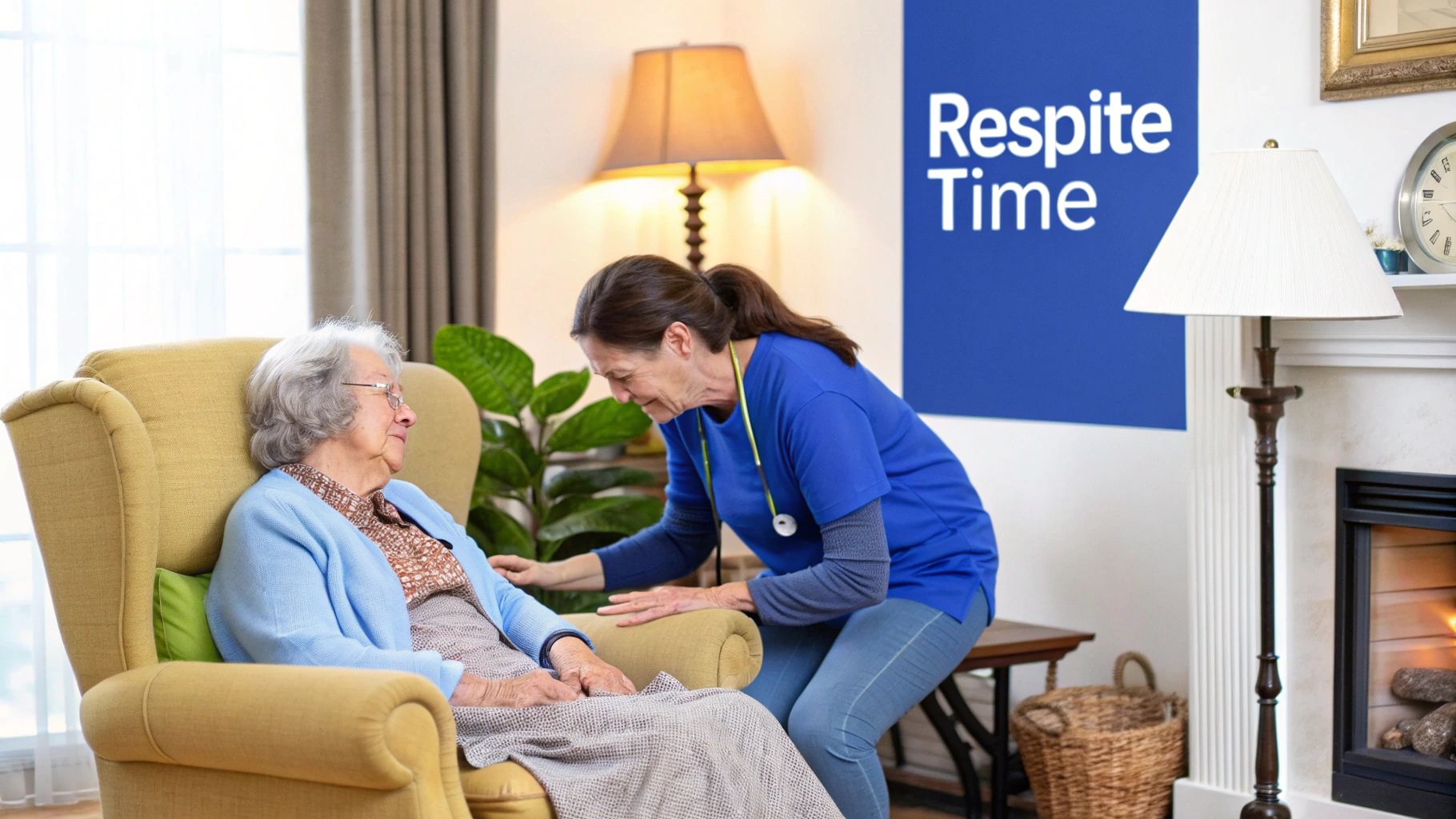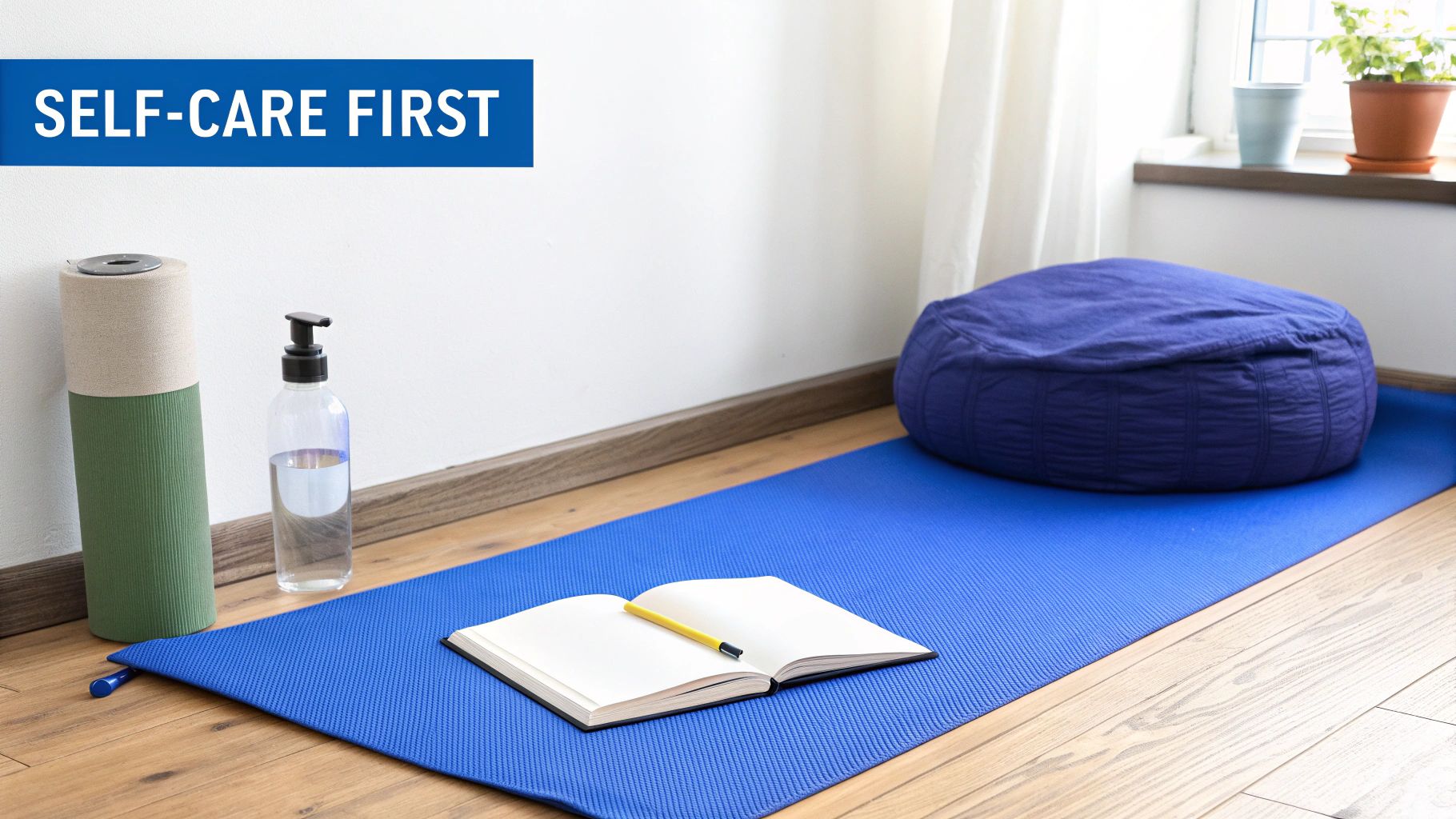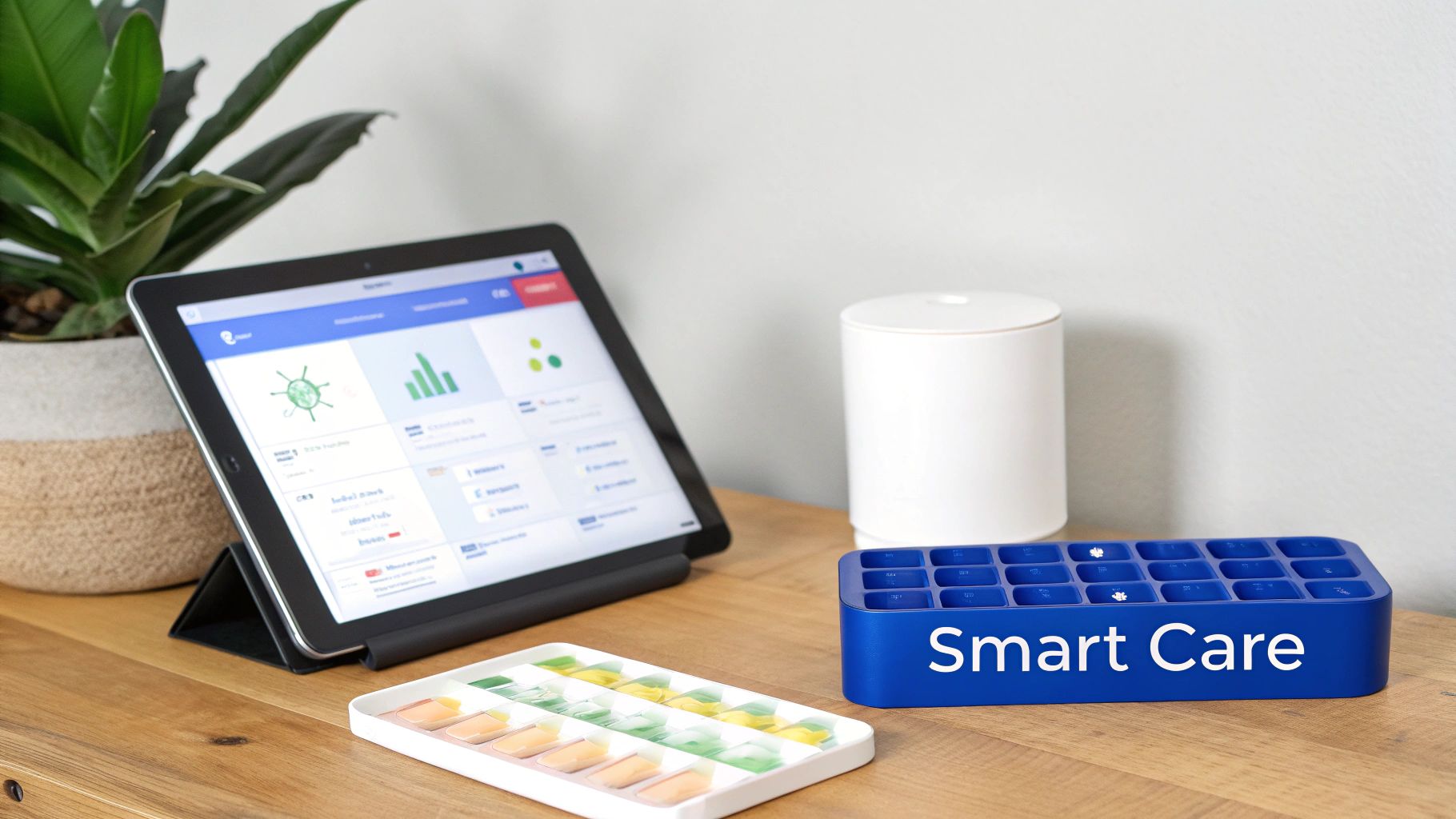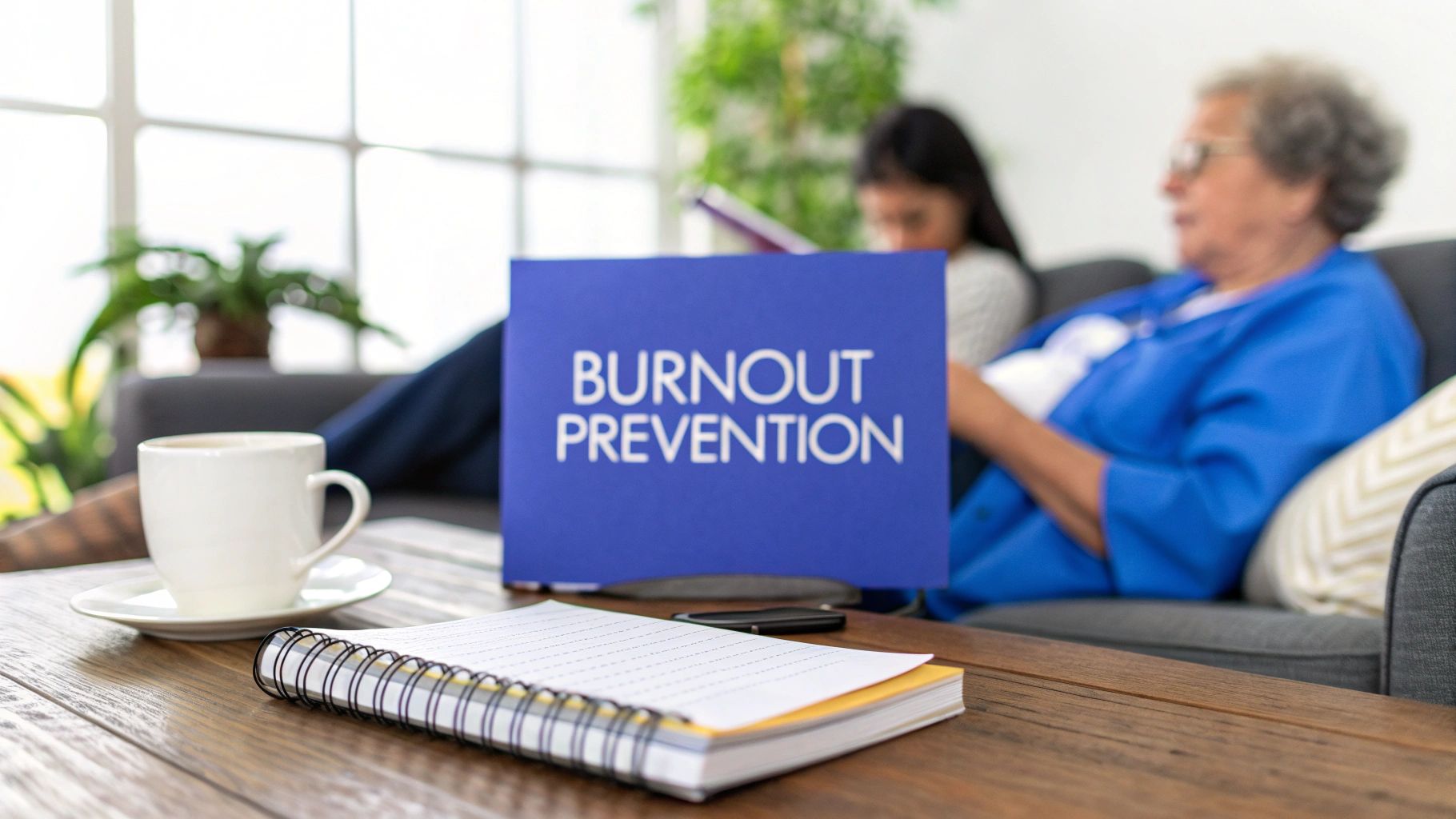Caregiving is an act of profound love and dedication, yet it often comes at a significant personal cost. The emotional, physical, and mental exhaustion known as caregiver burnout is a serious condition that affects millions, diminishing their ability to provide quality care while simultaneously impacting their own health. Recognizing the early signs, such as chronic fatigue, irritability, and social withdrawal, is the crucial first step.
However, true caregiver burnout prevention goes beyond simple recognition. It requires a proactive, strategic approach to safeguard your well-being while navigating the complex demands of providing care. It’s about building a sustainable system of support for yourself so you can continue to be there for your loved one without sacrificing your own health and happiness.
This guide offers eight powerful, actionable strategies designed for comprehensive burnout prevention. We'll explore practical solutions, from leveraging professional respite care and joining support groups to mastering the art of self-care planning and effective boundary setting. Each strategy provides concrete steps and real-world examples to help you build resilience, manage stress, and find balance. You will learn how to sustain yourself in this vital role, ensuring you can provide the best possible care for the long term.
1. Respite Care Services
Respite care is a cornerstone of effective caregiver burnout prevention. It provides primary caregivers with planned, temporary breaks by having a qualified professional or volunteer step in to handle caregiving responsibilities. This essential service allows you to recharge, attend to personal matters, or simply enjoy a period of rest, knowing your loved one is in safe hands.

This break can last anywhere from a few hours to several days, depending on your needs. The core benefit of respite care is that it directly addresses the relentless nature of caregiving, which is a primary driver of exhaustion and stress. By integrating regular breaks into your routine, you can maintain your own health and well-being, enabling you to provide better, more sustainable care long-term.
How to Implement Respite Care
Finding and using respite care can feel like another task, but breaking it down makes it manageable. Start by exploring the options available in your community.
- Adult Day Centers: These facilities offer structured programs in a community-based group setting for several hours a day. They provide social activities, meals, and medical monitoring.
- In-Home Respite: Agencies can send a trained aide to your home. This is often ideal for individuals with mobility issues or those who are more comfortable in familiar surroundings.
- Facility-Based Overnight Care: Many assisted living communities or nursing homes offer short-term stays, which is perfect for when you need to travel or require an extended break.
Actionable Tips for Success
To get the most out of respite care, proper planning is key.
- Start Small: Introduce your loved one to the respite provider or center for short periods first. This helps ease them into the new routine and builds trust.
- Prepare a Detailed Care Plan: Create a binder with essential information: medication schedules, dietary restrictions, daily routines, emergency contacts, and tips for managing challenging behaviors.
- Use the Time for Yourself: Resist the urge to fill your break with errands. Schedule something genuinely restorative, like a nap, a coffee with a friend, or a favorite hobby.
For more information and to find local providers, the ARCH National Respite Network and Resource Center is an excellent starting point.
2. Support Group Participation
Joining a support group is a powerful, proactive step in caregiver burnout prevention. These groups offer a safe, confidential space where individuals in similar situations can share their struggles, exchange practical advice, and provide mutual emotional validation. The feeling of isolation is a significant contributor to burnout, and support groups directly counteract this by creating a community of understanding peers.

Whether in-person, online, or a hybrid of both, these gatherings help normalize the complex emotions associated with caregiving, such as guilt, anger, and sadness. Hearing others voice the same concerns can be incredibly validating and reduces the burden of feeling like you are alone in your experience. This shared perspective fosters resilience and equips you with new coping mechanisms.
How to Implement Support Group Participation
Finding the right group is crucial for a positive experience. Many organizations offer specialized groups tailored to specific conditions or circumstances.
- Condition-Specific Groups: Organizations like the Alzheimer's Association or the American Cancer Society host groups for caregivers of individuals with those specific illnesses.
- Online Communities: Websites like CaringBridge or AARP’s online forums provide virtual support groups, which are ideal for those with limited mobility or unpredictable schedules.
- Local and Faith-Based Groups: Hospitals, community centers, and places of worship often facilitate general or faith-based caregiver support groups.
Actionable Tips for Success
To gain the most benefit, approach participation with an open and prepared mindset.
- Try a Few Options: Not every group dynamic will be the right fit. Visit a few different meetings, both online and in-person, to find one where you feel comfortable.
- Be an Active Participant: While it’s okay to just listen at first, try to share your own experiences when you're ready. The more you contribute, the more you and others will benefit.
- Prepare Talking Points: Before a session, jot down specific challenges you're facing or questions you have. This ensures you address your most pressing needs during the meeting.
For finding a local or virtual group, the Family Caregiver Alliance offers a comprehensive list of resources to get started.
3. Self-Care Planning and Implementation
Effective self-care is not an indulgence; it is a critical strategy for caregiver burnout prevention. This involves consciously creating and adhering to a routine that prioritizes your own physical, emotional, and mental health. This structured approach acknowledges that to provide consistent, compassionate care, you must first maintain your own well-being through dedicated practices like proper nutrition, exercise, and stress management.

Simply knowing you should practice self-care is different from actively doing it. The true benefit comes from implementation, which turns abstract goals into tangible, daily actions. By deliberately scheduling and protecting time for yourself, you build resilience against the chronic stress of caregiving, improve your mood, and boost your energy, ultimately making you a more patient and effective caregiver.
How to Implement Self-Care Planning
Integrating self-care into a demanding schedule requires a proactive, structured plan. Think of it as another non-negotiable part of your caregiving duties, but one that is entirely for you.
- Physical Wellness: Commit to daily movement, even if it's just a 20-minute walk. Plan and prep healthy meals on a weekly basis to avoid relying on convenience foods. Prioritize your own medical checkups and preventive care.
- Mental and Emotional Health: Use mindfulness apps like Headspace for short, guided meditations to manage stress. Establish a calming bedtime routine, such as reading or listening to music, to improve sleep quality.
- Social Connection: Schedule regular calls or short visits with friends. Engaging with your support system provides an essential outlet and reminds you of your identity outside of your caregiving role.
Actionable Tips for Success
To ensure your self-care plan is sustainable, focus on small, consistent steps.
- Start Small: Don't overwhelm yourself. Begin with a 10 to 15-minute commitment each day, like stretching in the morning or enjoying a cup of tea without distractions.
- Schedule It: Treat your self-care activities like important appointments. Add them to your calendar with reminders to ensure they don’t get pushed aside.
- Celebrate Progress: Acknowledge and celebrate your consistency. Recognizing these small victories reinforces the habit and motivates you to continue prioritizing your health.
4. Professional Counseling and Therapy
Professional counseling is a vital resource for effective caregiver burnout prevention. It offers a confidential space with a trained mental health professional to navigate the complex emotional, psychological, and relational challenges tied to caregiving. This support is tailored to your unique situation, helping you develop coping strategies, manage stress, and process feelings like grief, guilt, or resentment in a healthy way.

Unlike talking to friends or family, a therapist provides objective, evidence-based tools to reframe negative thought patterns and build emotional resilience. Engaging in therapy is a proactive step toward protecting your own mental health, which is essential for providing compassionate and sustainable care to your loved one. It acknowledges that your well-being is a critical component of the caregiving equation.
How to Implement Counseling and Therapy
Accessing mental health support is more feasible than ever with various formats and programs designed to meet different needs and budgets.
- Employee Assistance Programs (EAPs): Many employers offer EAPs that provide a set number of free, confidential counseling sessions for employees and their families.
- Specialized Caregiver Programs: Hospice organizations and disease-specific foundations (e.g., Alzheimer's Association) often provide free or low-cost counseling and support groups for families.
- Online Therapy Platforms: Services like BetterHelp or Talkspace offer convenient, flexible access to licensed therapists via text, phone, or video, which is ideal for busy caregivers.
- Private Practice Therapists: You can find specialists in grief, family dynamics, or chronic illness through directories like Psychology Today.
Actionable Tips for Success
To ensure therapy is effective, it’s important to find the right fit and approach it with a clear purpose.
- Seek a Specialist: Look for a therapist with experience in caregiver issues, grief counseling, or chronic illness. Their specialized knowledge will make your sessions more productive.
- Verify Coverage and Costs: Before you start, check with your insurance provider about mental health benefits. If you're paying out-of-pocket, inquire about sliding scale fees.
- Be Open and Honest: Your therapist is there to help, not to judge. Be candid about your frustrations, fears, and difficult emotions to get the most out of your sessions.
- Don't Settle: The therapeutic relationship is key. If you don't feel a connection with your therapist after a few sessions, it is perfectly acceptable to seek a different provider who is a better match.
5. Time Management and Boundary Setting
Effective time management and firm boundary setting are fundamental strategies for caregiver burnout prevention. This approach moves beyond simply managing tasks; it involves creating a structured framework that protects your personal time, energy, and emotional reserves. By consciously allocating your resources and learning to say "no" to unsustainable demands, you regain a sense of control over your life.
This strategy directly confronts the feeling of being constantly "on-call," which is a major source of mental and physical exhaustion. Implementing clear schedules and limits helps you carve out essential personal space, ensuring that caregiving does not completely consume your identity. This balance is crucial for maintaining the resilience needed to provide compassionate and consistent care over the long term.
How to Implement Time Management and Boundaries
Integrating these practices requires intentional planning and clear communication. The goal is to create a predictable and manageable routine that respects both your needs and your loved one's.
- Create Structured Schedules: Use a digital calendar like Google Calendar or a physical planner to block out specific times for care tasks, personal appointments, and non-negotiable rest periods. A visual schedule helps everyone understand the daily and weekly plan.
- Establish Communication Boundaries: Designate specific times of the day for returning non-urgent phone calls or messages from family members. This prevents constant interruptions and allows you to focus on the task at hand.
- Set Clear Visitor Guidelines: If multiple friends and family members visit, establish "visiting hours" to avoid a constant stream of guests that can be draining for both you and your loved one.
Actionable Tips for Success
Successfully setting boundaries is a skill that improves with practice.
- Start Small: Begin with one or two manageable boundaries, such as taking a 30-minute uninterrupted break each day. Success with small changes builds confidence for larger ones.
- Communicate Clearly and Kindly: When setting a boundary, explain it in a calm, firm, and non-apologetic way. For example, "I will be taking an hour for myself from 2-3 PM, so I won't be available then unless it's an emergency."
- Use Written Agreements: For shared family responsibilities, a written schedule or agreement can clarify who is responsible for what and when, reducing misunderstandings and resentment.
For in-depth resources on this topic, the Family Caregiver Alliance provides excellent guides on setting boundaries and managing caregiver stress.
6. Education and Skill Development
Knowledge is a powerful tool for caregiver burnout prevention. This strategy centers on empowering caregivers with the specific education, training, and practical skills needed for their unique situation. Feeling incompetent or unprepared can be a major source of stress and anxiety, but by building confidence in caregiving tasks, you can significantly reduce these negative feelings and improve outcomes for both yourself and your loved one.
Gaining mastery over tasks like medication management, safe transferring techniques, or understanding the progression of a disease like dementia transforms uncertainty into capability. This proactive approach helps you anticipate challenges and respond effectively, rather than reacting to crises. This sense of control is essential for maintaining your mental and emotional equilibrium, making caregiving a more manageable and less overwhelming role.
How to Implement Education and Skill Development
Acquiring new skills doesn't have to be an additional burden. Numerous accessible resources are designed specifically for family caregivers.
- Disease-Specific Workshops: Organizations like the Alzheimer's Association or the American Parkinson Disease Association offer workshops and seminars (both online and in-person) tailored to the challenges of a specific condition.
- Medical Training Courses: The American Red Cross provides essential training in First Aid, CPR, and even Certified Nurse Assistant (CNA) basics, which can be invaluable for hands-on care.
- Hospital and Clinic Programs: Many healthcare systems offer discharge planning education or condition-specific management classes, such as for diabetes or heart failure, to help families transition smoothly to home care.
Actionable Tips for Success
To make learning a sustainable part of your caregiving journey, integrate it thoughtfully.
- Focus on One Skill at a Time: Avoid overwhelming yourself. Identify the most pressing challenge you face, whether it's meal prep for a specific diet or communicating with someone with hearing loss, and master that first.
- Practice in Low-Stress Situations: Before you need a new skill in a high-stakes moment, practice it when you and your loved one are calm. Rehearse a transfer technique or a difficult conversation when the pressure is off.
- Keep Reference Materials Handy: Create a binder or a digital folder with quick guides, checklists, and key information. Having easy access to what you've learned can be a lifesaver.
For comprehensive resources and support, the AARP Caregiving Resource Center offers a wealth of guides, videos, and articles on a wide range of topics.
7. Technology Integration for Caregiving Efficiency
Integrating technology into your care routine is a powerful strategy for caregiver burnout prevention. It involves using smart devices, apps, and online services to streamline tasks, enhance safety, and improve communication, ultimately reducing the heavy administrative and emotional load that often accompanies caregiving. This approach automates and simplifies responsibilities, giving you more time and mental energy.
The primary benefit of using technology is efficiency and peace of mind. Automated medication dispensers can prevent dangerous errors, remote monitoring systems allow you to check in without being physically present, and communication platforms keep the entire family updated. By offloading these logistical burdens to reliable tech, you can focus on providing quality, compassionate care rather than getting lost in the overwhelming details.
How to Implement Technology
Adopting new technology doesn't have to be complicated. The key is to identify specific challenges in your care routine and find a tool designed to solve them.
- Automated Medication Management: Smart pill dispensers with alarms and smartphone notifications ensure medications are taken correctly and on time.
- Medical Alert Systems: Services like Medical Guardian provide wearable buttons that can summon help in an emergency, offering security for your loved one and reassurance for you.
- Communication Hubs: Platforms such as CaringBridge offer a private, centralized space to share health updates with family and friends, reducing the need for repetitive phone calls and texts.
- Remote Monitoring: Strategically placed home security cameras or smart sensors can help you check on a loved one’s safety and well-being from anywhere.
Actionable Tips for Success
To successfully integrate technology without adding more stress, follow these simple guidelines.
- Start with One Simple Tool: Don’t try to implement everything at once. Pick one area of high stress, like medication reminders, and introduce a single, user-friendly device first.
- Involve Your Loved One: Whenever possible, discuss the technology with your care recipient. Explaining how a tool helps them maintain independence can increase their willingness to use it.
- Create Backup Plans: Technology can fail. Always have a non-tech backup plan, such as a printed medication list or an emergency contact sheet easily accessible.
- Prioritize Privacy and Security: Before purchasing any device, especially one connected to the internet, research its privacy policy and security features to protect your loved one’s personal information.
8. Family Care Coordination and Shared Responsibility
Relying on a single primary caregiver is a direct path to exhaustion. Family care coordination is a powerful strategy for caregiver burnout prevention that involves formally organizing family members and friends into a cohesive team. By defining roles and sharing duties, you distribute the workload, prevent any one person from becoming overwhelmed, and create a more resilient support system for your loved one.
This approach transforms caregiving from a solitary burden into a collaborative effort. The core benefit is the significant reduction in individual stress and time commitment. When responsibilities are shared, each person can contribute in a manageable way, fostering a sense of teamwork and mutual support that strengthens family bonds while ensuring high-quality, continuous care.
How to Implement Family Care Coordination
Building a coordinated care team requires clear communication and organization. Start by treating it like a project with a shared goal: your loved one's well-being.
- Family Meetings: Hold a dedicated meeting (in-person or virtual) to discuss the care needs and openly assign roles. This ensures everyone is on the same page from the start.
- Shared Calendars: Use digital tools like Google Calendar or specialized family organizer apps (e.g., Cozi) to track medical appointments, medication schedules, and caregiver shifts.
- Task Delegation: Divide responsibilities based on skills and availability. A local sibling might handle in-person visits and appointments, while a long-distance family member could manage finances, research resources, or coordinate insurance paperwork.
Actionable Tips for Success
To ensure your coordinated effort runs smoothly, proactive management is crucial.
- Create a Written Plan: Document all agreed-upon roles, schedules, and contact information. This formal agreement serves as a reference point and minimizes misunderstandings.
- Schedule Regular Check-ins: Plan weekly or bi-weekly conference calls to provide updates, address challenges, and adjust the plan as needs change. This maintains open lines of communication.
- Consider a Neutral Facilitator: If family dynamics are complex or conflicts arise, a family therapist or mediator can help facilitate productive conversations and find common ground.
For comprehensive guides on creating a family care plan, resources from the Family Caregiver Alliance offer valuable templates and advice.
Caregiver Burnout Prevention Strategies Comparison
| Strategy | Implementation Complexity 🔄 | Resource Requirements ⚡ | Expected Outcomes 📊 | Ideal Use Cases 💡 | Key Advantages ⭐ |
|---|---|---|---|---|---|
| Respite Care Services | Medium – Scheduling & provider vetting | Moderate – Professional/volunteer staff | Temporary caregiver relief, reduced burnout | Caregivers needing short-term breaks | Prevents exhaustion, improves care quality |
| Support Group Participation | Low – Attend meetings regularly | Low – Often free or low-cost | Emotional support, reduced isolation | Caregivers seeking peer support | Emotional validation, shared practical tips |
| Self-Care Planning and Implementation | Medium – Routine establishment | Low to moderate – Time and possible costs | Better physical/mental health, increased resilience | Caregivers aiming for sustained wellbeing | Improves health, customizable |
| Professional Counseling and Therapy | High – Scheduling and attending sessions | Moderate to high – Licensed professionals | Mental health improvement, coping skills | Caregivers with emotional/psychological needs | Expert guidance, personalized treatment |
| Time Management and Boundary Setting | Medium – Habit and communication building | Low – Mainly tools and time | Increased productivity, protected personal time | Caregivers overwhelmed with duties | Reduces chaos, enforces limits |
| Education and Skill Development | Medium – Time for learning | Low to moderate – May require courses | Increased competence, reduced anxiety | New or inexperienced caregivers | Builds skills, improves care quality |
| Technology Integration for Caregiving Efficiency | Medium – Setup and learning curve | Moderate to high – Devices and apps | Streamlined tasks, better monitoring | Tech-savvy caregivers looking to optimize | Saves time, improves accuracy & communication |
| Family Care Coordination and Shared Responsibility | High – Needs ongoing communication | Low to moderate – Coordination tools | Distributed caregiving, reduced individual stress | Families with multiple caregivers | Shares burden, strengthens family bonds |
Building a Sustainable Caregiving Journey
Navigating the complex landscape of caregiving is a marathon, not a sprint. The strategies detailed throughout this article, from leveraging professional respite care to establishing firm personal boundaries, are not isolated solutions. Instead, think of them as interconnected pillars supporting your long-term well-being and effectiveness. True, sustainable caregiver burnout prevention is built by weaving these practices into the very fabric of your daily life, creating a resilient framework that can withstand the inevitable challenges and emotional demands of your role.
The journey of a caregiver is profoundly personal, yet the need for a strong support system is universal. You are the anchor for your loved one, and an anchor must be secure. The key takeaway is that prioritizing your own health is not a selfish act; it is the most fundamental requirement for providing consistent, compassionate, and high-quality care. Neglecting your needs directly impacts your ability to meet theirs.
Your Action Plan for Resilience
To move from understanding to action, consider these immediate next steps. Don't try to implement everything at once. Choose one or two areas that feel most urgent and start there.
- Review Your Support Network: Take 30 minutes this week to list every potential source of help. This includes family members you can delegate tasks to, friends who can offer emotional support, and professional services like NJ Caregiving. Identify one person or service you can reach out to in the next seven days.
- Schedule Your "Non-Negotiables": Look at your calendar for the upcoming month. Block out at least two short, non-negotiable appointments for yourself. This could be a 20-minute walk, a therapy session, or dedicated time to participate in an online support group. Treat these appointments with the same importance as a doctor's visit for your loved one.
- Embrace Imperfection: Let go of the "perfect caregiver" myth. Acknowledge that you will have difficult days, and that's okay. The goal is not perfection but sustainability. Mastering this mindset shift is crucial for long-term caregiver burnout prevention and protects your mental and emotional health.
By proactively building these habits, you transform caregiving from a role that consumes you into one that can coexist with your own identity and well-being. You are more than a caregiver; you are a whole person deserving of rest, support, and a fulfilling life. Embracing these strategies ensures that you can continue to provide love and care from a place of strength and renewal, not depletion. Your wellness is the foundation upon which effective care is built. Protect it fiercely.
Are you feeling the weight of your responsibilities and searching for reliable support? The dedicated professionals at NJ Caregiving specialize in providing compassionate respite care and in-home assistance, giving you the essential break you need to prevent burnout. Visit NJ Caregiving to learn how their customized care plans can help restore balance to your life and ensure your loved one receives the best possible support.


